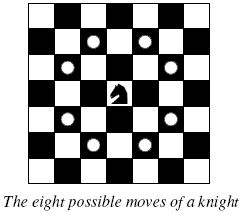A Knight's Journey
Time Limit : 2000/1000ms (Java/Other) Memory Limit : 131072/65536K (Java/Other)
Total Submission(s) : 10 Accepted Submission(s) : 4
Problem Description
 Background
Background The knight is getting bored of seeing the same black and white squares again and again and has decided to make a journey
around the world. Whenever a knight moves, it is two squares in one direction and one square perpendicular to this. The world of a knight is the chessboard he is living on. Our knight lives on a chessboard that has a smaller area than a regular 8 * 8 board, but it is still rectangular. Can you help this adventurous knight to make travel plans?
Problem
Find a path such that the knight visits every square once. The knight can start and end on any square of the board.

Input
The input begins with a positive integer n in the first line. The following lines contain n test cases. Each test case consists of a single line with two positive integers p and q, such that 1 <= p * q <= 26. This represents a p * q chessboard, where p describes how many different square numbers 1, . . . , p exist, q describes how many different square letters exist. These are the first q letters of the Latin alphabet: A, . . .
Output
The output for every scenario begins with a line containing "Scenario #i:", where i is the number of the scenario starting at 1. Then print a single line containing the lexicographically first path that visits all squares of the chessboard with knight moves followed by an empty line. The path should be given on a single line by concatenating the names of the visited squares. Each square name consists of a capital letter followed by a number.
If no such path exist, you should output impossible on a single line.
If no such path exist, you should output impossible on a single line.
Sample Input
3
1 1
2 3
4 3
Sample Output
Scenario #1:
A1
Scenario #2:
impossible
Scenario #3:
A1B3C1A2B4C2A3B1C3A4B2C4
如图,对于骑士所在的位置,所标识的1 2 3 4...位置就是组成字典序的顺序。
 View Code
View Code
1 #include <iostream> 2 #include <stdio.h> 3 #include <string.h> 4 using namespace std; 5 6 int vis[26][26],path[26][2]; 7 int flag,a,b; 8 9 int dir[8][2]={-2,-1,-2,1,-1,-2,-1,2, //这样子排数字是为了保证字典序 10 1,-2, 1,2, 2,-1, 2,1}; 11 12 void dfs(int s,int t, int k) 13 { 14 int i,j; 15 if(k==a*b) 16 { 17 for(i=0;i<k;i++) 18 printf("%c%d",path[i][0]+'A',path[i][1]+1); 19 printf("\n"); 20 flag=1; 21 } 22 else 23 { 24 for(j=0;j<8;j++) 25 { 26 int n=s+dir[j][0]; 27 int m=t+dir[j][1]; 28 if(n>=0 && n<b && m>=0 && m<a && vis[n][m]==0 && !flag) 29 { 30 vis[n][m]=1; 31 path[k][0]=n; 32 path[k][1]=m; 33 dfs(n,m,k+1); 34 vis[n][m]=0; 35 } 36 } 37 } 38 } 39 40 int main() 41 { 42 int n,t; 43 scanf("%d",&n); 44 for(t=1;t<=n;t++) 45 { 46 flag=0; 47 int i,j; 48 scanf("%d%d",&a,&b); 49 for(i=0;i<a;i++) 50 { 51 for(j=0;j<b;j++) 52 { 53 vis[i][j]=0; 54 } 55 } 56 vis[0][0]=1; 57 path[0][0]=0;path[0][1]=0; 58 printf("Scenario #%d:\n",t); 59 dfs(0,0,1); 60 if(flag==0) printf("impossible\n"); 61 printf("\n"); 62 } 63 //system("pause"); 64 return 0; 65 }
